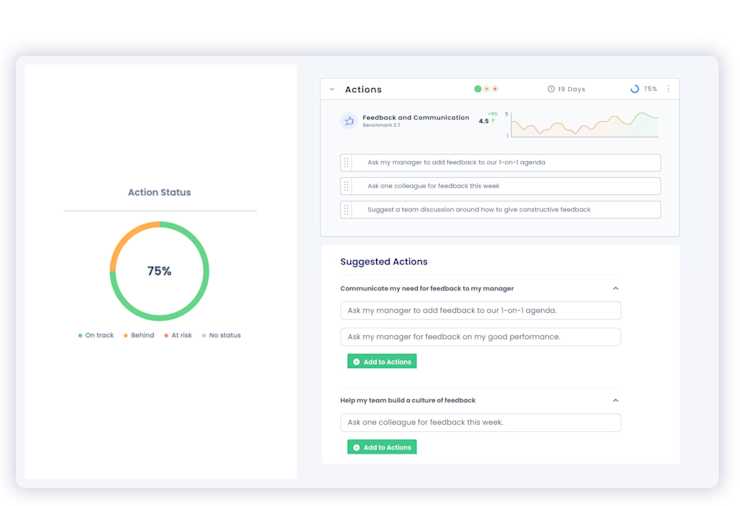Employee engagement is not just a buzzword; it's a vital element that drives productivity, morale, and overall business success. Discover our ultimate employee engagement guide today.
Employee engagement is becoming increasingly important.
A strong company culture with high engagement among the employees can increase revenue 4x. And yes, there is very little practical advice about how to actually get there.
That is why, in this ultimate guide, we'll break down the definition of employee engagement, explore its different types, discuss its benefits, and provide a framework for creating an effective employee engagement strategy. The goal if for you to feel comfortable in working toward increasing engagement in your organisation after reading this blog post.
Let’s dive in…
What is employee engagement?
Our definition is: "the level of an employee's psychological investment in their organisation."
Let’s break that down a bit.
Employee engagement is the emotional commitment and involvement an employee has towards their organisation and its goals. It significantly impacts productivity, morale, and overall business success.
A highly engaged workforce isn't just happy or satisfied with their job; they're enthusiastic about it and are therefore willing to do more.
They take positive action to further the company's reputation and interests, benefiting everyone in the company.
Types of employee engagement
Emotional engagement: This is about how valued employees feel at work. When staff feel a strong bond with their job, they usually show improved productivity.
Cognitive engagement: This relates to how deeply employees immerse themselves in their roles on a day-to-day basis.
Physical engagement: This refers to the energy levels that individuals bring into performing tasks at work. Engaged staff are energetic contributors who actively participate in team activities.
💡Pro tip: Employee engagement is very different to employee experience. Read our full guide on EX here.

Benefits of employee engagement
The impact on productivity
Employees who feel connected to their job display heightened levels of productivity, as they sense a sense of value and are inspired to exceed expectations in order to further the company's objectives.
They're motivated to go above and beyond their job requirements, contributing positively towards the company's goals.
A Gallup study found that highly engaged teams show 21% greater profitability.
Better retention rates
Turnover rates are reduced in a positive work environment. Especially if staff members feel appreciated and connected to the organisation.
According to Forbes, companies with high levels of employee engagement have reduced attrition rates by up to 59%.
Improved customer satisfaction
An often-overlooked benefit of employee engagement is its direct correlation with customer satisfaction.
Engaged employees provide superior service as they understand the value they bring in shaping customer experiences, ultimately leading to higher customer loyalty scores.
Mitigating risks
Last but not least, having an effective employee engagement plan mitigates risks associated with disengagement such as low morale, poor performance or even reputational damage due to negative word-of-mouth from disgruntled staff members.

The building blocks of an effective employee engagement strategy
To build a robust employee engagement strategy from scratch, consider the following key elements:
Leadership commitment: Leaders should demonstrate their commitment to employee engagement by setting clear expectations and leading by example.
Clear communication: Regularly communicate with employees about company goals, changes in policies or procedures, and other important information.
A culture of recognition: Recognise and reward employees for their contributions to the company's success.
Balanced Work-Life Initiatives: Offering flexible working hours or remote work options can significantly enhance job satisfaction, leading to higher levels of engagement.
Career development opportunities: Provide opportunities for career growth within your organisation. This could include training programs or mentorship initiatives.
A framework for your employee engagement strategy
Our roadmap outlines what needs to be done at each stage of the process - from identifying drivers of disengagement through action planning and monitoring progress towards achieving set objectives.
This framework not only guides you on where efforts need focus but also allows tracking improvements over time which is essential in measuring effectiveness of implemented strategies.
Remember that building an engaging work environment isn't something achieved overnight; it requires consistent effort and dedication across all levels within your organisation.
Be inspired to go from insight to action
In addition to our template, we offer a guide for how to go from insight to action.
It includes purpose statements, scope descriptions, principle guidelines, and roles and responsibilities outlines.
Remember, every successful employee engagement strategy starts with clear-cut policies. Download: From Insight to action In Eletive you can also manage your own action plans.
How to create an employee engagement plan (step-by-step)
Establish goals and objectives
An effective employee engagement plan starts with clear goals and objectives that align with your organisation's overall business strategy.
This ensures that all efforts contribute towards the same end.
Define what you want to achieve through your employee engagement initiatives, first.
This could range from improving job satisfaction levels, increasing productivity, reducing staff turnover rates, or fostering a positive company culture.
Enhance job satisfaction
A satisfied employee is likely to be more engaged at work. Therefore, one of the main objectives can be enhancing job satisfaction by providing opportunities for career growth and recognising employees' contributions.
Boost productivity
Engaged employees are often more productive than their disengaged counterparts. So another objective could be boosting productivity by creating an environment where employees feel valued and motivated.
Reduce staff turnover
High staff turnover can disrupt operations and negatively impact morale among remaining team members. Hence, retention might also feature as a key goal in your plan.
Foster positive company culture
An engaging workplace culture encourages teamwork, innovation, and mutual respect, which contributes significantly towards achieving organisational goals.
Identify engagement drivers
Once you have clear goals in mind, the next step is to identify what motivates your employees and drives their commitment to the organisation.
These drivers are unique aspects that influence job satisfaction, recognition, career development opportunities, and team dynamics.
Job satisfaction
Employees who find fulfilment in their roles tend to be more engaged at work. This could stem from challenging tasks or a supportive work environment. It's important for HR managers to understand what makes employees satisfied with their jobs by conducting regular employee surveys.
Recognition
Acknowledging an employee's hard work can significantly boost morale and foster loyalty. Implementing a system where peers can recognise each other's efforts is one way of driving engagement. Check out this Forbes article for more ideas on how to recognise your employees.
Career development opportunities
The opportunity for growth within the company is another significant driver of employee engagement. Providing training programs or mentorship schemes can help individuals see a clear progression path in your organisation.
Team dynamics
A positive workplace culture encourages collaboration among team members, leading to increased productivity and overall job satisfaction. Check out this HuffPost article for tips on how to improve team dynamics in your workplace.
To successfully identify these drivers within your organisation, consider using Eletive. We provide actionable insights into employee sentiments and behaviours.
By taking the time to analyse these elements, it is possible to develop a tailored plan that addresses your team's specific requirements.
Develop an action plan
So, you've figured out what drives employee engagement in your organisation.
Now, it's imperative to construct a comprehensive scheme of action in order to increase employee engagement. This step is crucial, as it lays out how you will address each driver and boost overall engagement.
Action steps
Your action plan should include specific steps for each engagement driver. For instance, if job satisfaction is a significant factor, consider initiatives like improving working conditions or offering more opportunities for career advancement.
Timelines
Every action step needs a clear timeline for implementation. Timely execution ensures that employees see consistent efforts towards enhancing their work experience, which can boost morale and further increase engagement levels.
Eletive's guide on creating an effective employee engagement action plan
Here’s how you can formulate actionable strategies that align with your organisational goals and objectives.
Prioritise actions based on impact:
If recognition is a major driver, prioritise actions such as setting up regular appreciation events or implementing peer-to-peer recognition programs.
If team dynamics are important, focus on activities that foster collaboration and teamwork, such as team-building exercises or collaborative projects.
In essence, developing an effective employee engagement strategy involves understanding what motivates your employees and devising targeted interventions based on these motivations. Remember: every successful journey begins with a well-laid-out map.
Here’s what your action plan should look like…

Variety in engagement programs
Different organisations require different approaches depending on factors like company culture, size, and industry sector. Some may benefit from team-building exercises or social events, while others might focus more on professional development opportunities or flexible working arrangements.
Social events and team building activities
Team-building activities and social events can help to build relationships between employees, leading to enhanced collaboration and communication within the workplace.
Career development opportunities
Career development programs that offer training courses or mentorship schemes help employees feel valued by providing them with opportunities for growth within the organisation.
Flexible working arrangements
Flexible work schedules allow employees to balance their personal lives with their professional responsibilities effectively, leading to increased job satisfaction levels over time. Remember: The key is understanding your workforce's needs and tailoring your program accordingly.
Monitor progress
Boosting employee engagement is not just about implementing strategies, but also monitoring progress. Regular check-ins and the use of engagement metrics are crucial to ensure that your plan is on track and achieving its set goals.
Use engagement metrics
To effectively monitor progress, you need to use engagement metrics. These could include survey results, feedback scores or performance indicators directly linked with engagement levels such as productivity rates or absenteeism figures.
Schedule regular check-ins
Holding regular check-ins with employees can provide key information on their work satisfaction and feelings towards the organisation. This could be done through one-on-one meetings, team huddles or even anonymous suggestion boxes.
Leverage technology
Utilising technology like Eletive's Real-Time Pulse Surveys can make tracking easier by providing real-time data about employee sentiments and concerns. It's an efficient way of gathering information without causing disruption in daily operations. Eletive is the place where technology meets psychology.
Remember, avoid micromanaging as it may lead to decreased motivation among staff members. Emphasise constructing an atmosphere where personnel sense treasured and heard, which can lead to heightened involvement eventually.
Evaluate results
Once your employee engagement plan is in motion, it's crucial to evaluate the results. This isn't just about ticking boxes or fulfilling a formality - it's an opportunity to measure success and identify areas for improvement.
The first step in evaluating results is gathering data. You can do this through surveys, feedback sessions, performance metrics and other tools provided by platforms like Eletive. Remember that effective evaluation requires both quantitative (numbers) and qualitative (feedback) data.
Data analysis
After collecting the necessary information, you'll need to analyse it. Look for trends and patterns that indicate whether your engagement strategies are working as expected. Are employees more satisfied? Has productivity increased? If not, what factors could be contributing?
Actionable insights
Your analysis should yield actionable insights - specific changes you can make to improve engagement levels further. Perhaps communication needs strengthening or recognition programmes require tweaking; these findings will guide your next steps.
Continuous improvement process
Evaluation shouldn't be a one-off event but part of a continuous improvement process within your organisation's culture. By regularly assessing the impact of your initiatives on employee engagement levels, you're better positioned to adapt swiftly when needed.
In essence, evaluating results helps ensure that resources invested into enhancing employee engagement aren't wasted but contribute meaningfully towards achieving desired outcomes - happier staff who perform at their best.

Successful implementations
Leading companies have seen remarkable results through their employee engagement initiatives. For instance, Eletive's customer stories showcase how effective these programs can be when implemented correctly. These real-world examples serve as an inspiration and guide for HR managers looking to improve their practices.
Conclusion
By prioritising elements like leadership commitment, clear communication, recognition, work-life balance, and career development, you can cultivate a highly engaged workforce.
Once you do that?
You’ll need to monitor progress and evaluate your results. To ensure continuous improvement.
Follow the knowledge we outlined in this guide to create a positive work environment and reap the rewards of engaged employees.
If you need a reliable platform to help you do this check out Eletive.

























